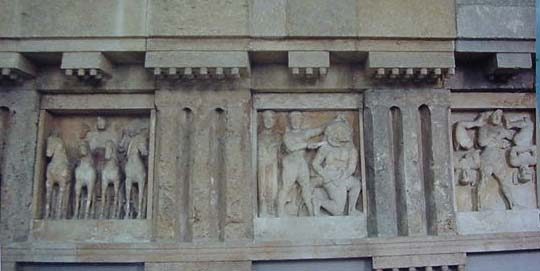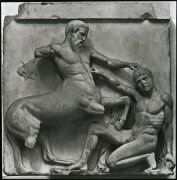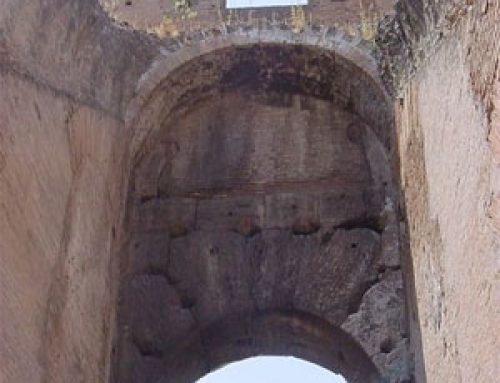
Greek temple at Agrigento, Sicily
What are triglyphs and metopes?
Most Greek temples have a pattern under the pediment known as triglyphs and metopes. The triglyphs alternate with the metopes across the front of the temple. Triglyphs (TRY-gliffs) have three parts, and then in between the triglyphs are the metopes (MET-oh-peas).
Early Greek temples
What is a pediment?
The Doric order
Egyptian temples
More Greek architecture
All our ancient Greece articles

Perseus killing Medusa (in the middle)
Why have triglyphs and metopes?
They started as a natural part of wooden temples, back in the early days when people in Greece were building temples out of logs. The triglyphs were the ends of the wooden beams of the roof, and the metopes were the spaces between the beams. When architects began building stone temples, they wanted them to look familiar, so they kept the pattern, even though it had nothing to do with the structure anymore.

Parthenon (Athens, Greece)
Relief carving on metopes
Sometimes (as on the temple from Agrigento) the metopes are plain. On other temples, like the one here (also from Sicily), the metopes carry carved mythological scenes. The center metope up above shows Perseus killing Medusa.
The story of Perseus and Medusa
Who was Medusa?
More Greek myths

Metope from the Parthenon
Metopes on the Parthenon
On the Parthenon, the carved metopes represent a battle between the Lapiths and the centaurs. The Parthenon’s all about the battle between civilization and barbarism, order and chaos, and here the Lapiths (because they’re men) represent order and the centaurs (because they’re not men) represent chaos. On some of the metopes the Lapiths are winning, and on others the centaurs are winning.
Order and chaos in Greek thought

Another metope from the Parthenon
Rhythm and mathematics
To people in ancient Greece, architecture was an important part of order. Rhythm and mathematics were part of that order, and so they were important parts of civilization. People thought of temples as a kind of visual metaphor for music. In this metaphor, triglyphs and metopes provide a rhythm that steadies the melody of the pediment carvings.
Rhythm in Greek temples
Greek mathematics
What was Greek music like?
Why don’t all temples have triglyphs and metopes?
Triglyphs and metopes were common on Doric temples, but on Ionic temples the old metopes were usually replaced with a continuous frieze. The Parthenon is unusual in having both metopes and a frieze.
The Parthenon in Athens
The Parthenon’s metopes
Ionic temples
What is a frieze?
Learn by doing: Choose aGreek mythto illustrate in metopes with triglyphs between them
More about the Doric order
Bibliography and further reading about Greek architecture:
Ancient Greek Architects at Work, by J. J. Coulton (1982). An interesting look at how Greek architects worked.
Greek Architecture, by A. W. Lawrence, R. A. Tomlinson (5th edition 1996). Might be a bit out of date.




